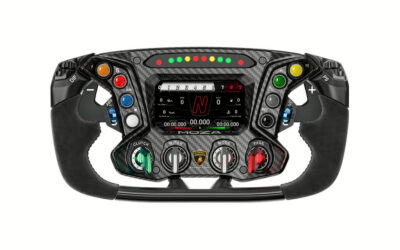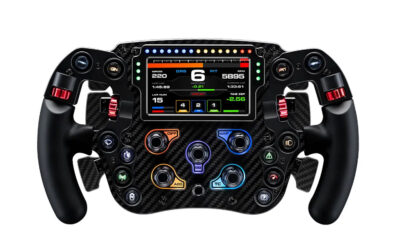CAMMUS C5 (Bundle)
Benefits
- Competitive price in the segment
- 5 nm constant torque and 6 nm peak torque
- LED display, RevLED and numerous controls on the steering wheel faceplate
Disadvantages
- A design that won’t please everyone
- 2 tiny rear paddles
Our rating : 9.2/10
The sim-racing world is full of brands operating in various segments. We have manufacturers who offer products that are cheap, affordable and for the Sunday virtual racer. We also have brands that touch on everything in sim-racing, from the affordable to the mid-priced to the premium. And we also have players who are present in the elitist segments. It’s really a mix of competitors who coexist more or less in perfect harmony, for the benefit of consumers and other drivers.
As far as brands are concerned, I can mention, for example Thrustmaster, Logitech, Simagic, Fanatec, Moza Racing, Simucube, Asetek SimSportsand many others. Each of these brands was active in its own segment, but with global changes, you have to adapt to survive. Logitech, for example, focused on the entry-level segment with inexpensive bundles that were perfect for the average gamer. The Swiss brand uses gear-drive technologies to provide force feedback on its bases. Recently, however, the brand launched its first Direct Drive base . G Pro to compete with Fanatec and Moza, among others of course.
Among all the other players present, we have the brand Cammusyou probably don’t know. Like Moza Racing, it’s a Chinese manufacturer of sim-racing peripherals, aiming to gain a share of the world market in the long term. Its catalog currently includes 3 Direct Drive bases, including the C5, with an atypical approach to motors: instead of having the motor in the base, it’s located directly in the rear structure of the steering wheel. In what follows, I’m going to introduce you to the C5, which is the ticket to the world of DD bases with the lowest price on the market, excluding promotions of course.
Main and technical features of the bundle
- Flywheel-mounted motor develops 5 nm of constant torque, and 6 nm at peak
- Bundle including flywheel with motor, crankset and clamp with integrated cooling system
- Leather-like steering wheel with flat bottom
- Aluminum faceplate with around 20 controls, including 3 encoders and 2 small rear-mounted paddles
- Carbon fiber finish on faceplate
- PC-compatible
Design
Although design remains a subjective element, the Cammus C5’s steering wheel is either to be liked or disliked. As for the wheel, its shape remains fairly standard, with a flat bottom. The faceplate, on the other hand, is anything but normal. At first glance, the resemblance to a steering wheel is striking. Pagani is just blatantly obvious, and I wouldn’t be at all surprised to learn that the brand’s designers were inspired by the Italian Hypercar.
The faceplate is completely round, and a good size. It’s as if you’ve got a little steering wheel inside, and it also looks like the steering wheels on Mini Coopers. The carbon-fiber skin in the center tries to give it a premium look, but it’s no easy feat. There’s the brand logo, which I have to say is rather handsome, with a multitude of controls scattered all over the faceplate, which is a nice way of saying it’s loaded.
As for the pedalboard, it’s rather minimalist: a plate with 2 identical pedals and a logo in the middle. As I said above: either you like it or you don’t.
Customized assembly
Supplied with the C5 is a clamp that not only secures the wheel to the furniture, but also cools the motor at the back of the wheel. There are 2 screws underneath to secure the steering wheel to any table, without any movement.
For the pedalboard, the main plate incorporates 4 holes, with 2 more on each pedal, to secure this peripheral on all sim-racing setups (chassis, stand, etc.).
Manufacturing and finishing
The pedalboard uses metal for its entire structure, as do the pedals. Not bad at all for a bundle that claims to be less expensive than an entry-level Logitech or Thrustmaster (more on that later).
The steering wheel/base uses leather or imitation leather all around. Honestly, I don’t know what material Cammus used, but it’s quality in your hands. On the other hand, the finish isn’t the most attractive, I must admit. It’s pretty well finished in the main, but nothing more. The stitching is a little off in some places, especially at the end of the track, if you know what I mean.
The structure of the steering wheel is made of aluminum for strength, as the Direct Drive motor is strangely located at the rear of the wheel, and not on a base per se. On this point, the finish is better than Thrustmaster’s lower-end competition.
Getting started with the bundle
The C5’s steering wheel feels pretty good in the hand, and this is largely due to its standard flat-bottomed shape. The wheel thickness is good, which will help you a lot when you’re racing, and that’s not bad at all for such an inexpensive steering wheel.
As for the controls, they are spread out over practically the entire faceplate of the C5. Most can be reached without too much trouble, but some encoders are in the middle of the steering wheel, requiring a little hand gymnastics. This is the case with virtually all steering wheels, so there’s nothing to worry about here.
Sensations during play
The pedals
Keep in mind that the Cammus C5 is an entry-level Direct Drive bundle. It’s cheap, and there’s a good reason for that. The C5’s pedalboard is the most standard on the market: 2 identical pedals with the same resistance; in other words, virtually none at all. I’m not going to be picky, and this pedalboard does the job it’s asked to do, while being better than an On/Off button.
The steering wheel
The C5 is designed to compete with Logitech G923 and Thrustmaster T248. Niveau prix, ça tombe pile poil sur la cible. Niveau sensation, c’est mieux que ces deux concurrents. Le retour de force est pas mal pour un bundle d’entrée de gamme. Vous allez ressentir les effets produits par le moteur graphique du jeu, mais ne vous attendez pas à ce que ça soit une expérience extraordinaire, car ça ne le sera pas du tout.
For settings, the software is still in beta phase, but you’ll be able to find what you’re looking for on Asseto Corsa or iRacing without too much difficulty. You just need to spend some time fine-tuning everything to get the right experience.
Compatibility
Unsurprisingly, C5 is PC-compatible only. And I don’t think we can expect to see it supported on consoles for some time to come. As for sim-racing titles, the list is long and includes AC, ACC, rFactor, iRacing, Dirt, F1, and the list goes on.
Value for money
The bundle is currently on special offer at $249 on the manufacturer’s website, down 29% from the original price of $349. Okay, the build quality isn’t crazy, the materials aren’t premium, but at the same time, this bundle takes on the entry-level Logitech and Thrustmaster. I’d say the value for money is decent. In most cases, it’s enough for a novice or beginner.
My verdict
The Cammus C5 is a very interesting bundle (flywheel/base + pedalboard), I must say. It is in no way comparable to a 5 nm CSL DD or an R5. The difference in size between the motors of these bases is just blatant, and I’m not talking about the controllers and other software for setting the electronic components. And Cammus is well aware of this, as the brand is targeting a specific market: bundles with belt or gear drives.
If you have a budget of up to €300, the C5 represents an excellent alternative to the G923 and T248, and even other bundles from Logitech and Thrustmaster. If you can afford more, then you’re better off with a much better bundle, such as a GT DD PRO from Fanatec or a Moza R5 Bundle.













0 Comments